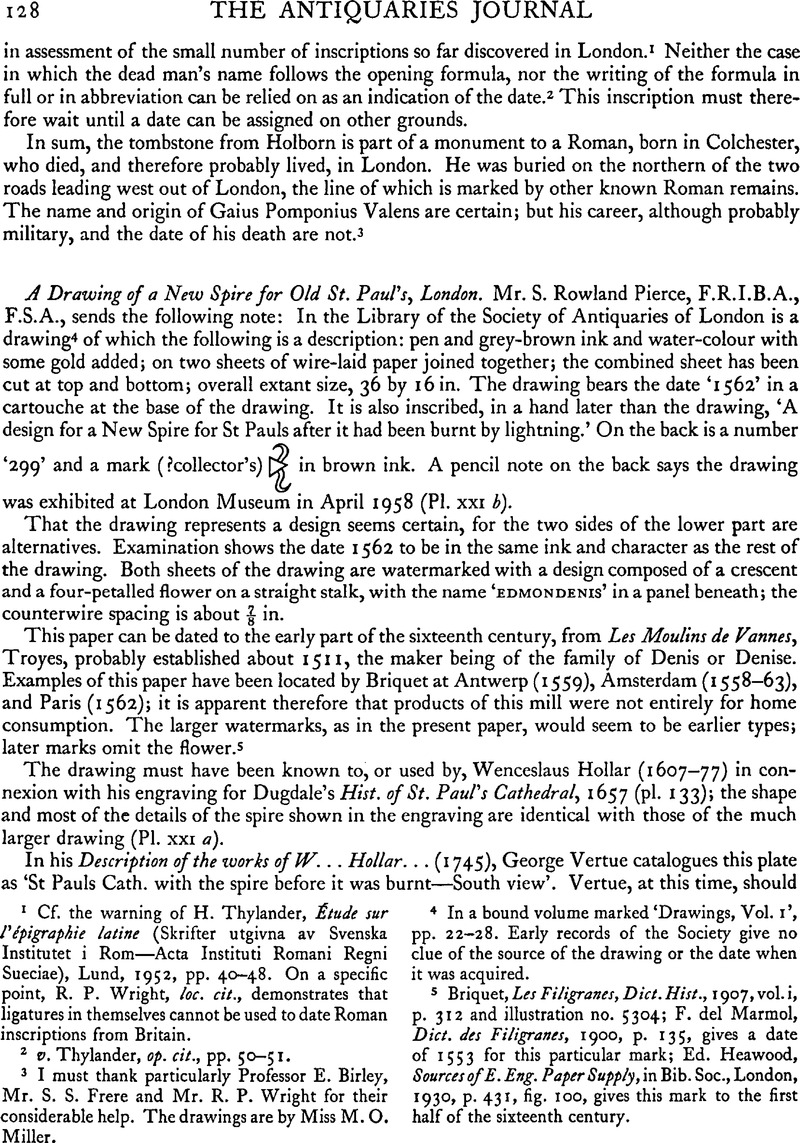Article contents
A Drawing of a New Spire for Old St. Paul's, London
Published online by Cambridge University Press: 29 November 2011
Abstract

- Type
- Notes
- Information
- Copyright
- Copyright © The Society of Antiquaries of London 1963
References
page 128 note 4 In a bound volume marked'Drawings, Vol. 1’, pp. 22–28. Early records of the Society give no clue of the source of the drawing or the date when it was acquired.
page 128 note 5 Briquet, , Les Filigranes, Dict. Hist., 1907, vol. i, p. 312Google Scholar and illustration no. 5304; del Marmol, F., Dict. des Filigranes, 1900, p. 135Google Scholar, gives a date of 1553 for this particular mark; Ed. Heawood, , Sources of E. Eng. Paper Supply, in Bib. Soc., London, 1930, p. 431, fig. 100Google Scholar, gives this mark to the first half of the sixteenth century.
page 129 note 1 See also Partheny, G., Wenzel Hollar, 1858Google Scholar.
page 129 note 2 Hind, , Cat. of the Work of W. Hollar, 1922, p. 56Google Scholar.
page 129 note 3 B.M., Add. MS. 23068; and Walpole Soc., xviii (Vertue I), 49.
page 129 note 4 Evans, Joan, Hist. of Soc. of Antiquaries, 1956Google Scholar.
page 129 note 5 A drawing of a strange classical design, by Inigo Jones, for the finish of the truncated tower is, or has been, in the possession of Worcester College, Oxford, but I understand it cannot now be located.
page 129 note 6 P.R.O., Misc. Books, i. 66, E/101 and E/164.
page 130 note 1 It is nothing more than a coincidence that the 54th Dean of St. Paul's was Henry Cole (1500?–1580); he was apparently replaced by William May, the Dean at the time of the fire, in 1559 or 1560, as a result of the death of Queen Mary and the accession of Queen Elizabeth. D.N.B., etc.
page 130 note 2 The church stood in Threadneedle Street; it was founded about 1368 and finished about 1462; it was demolished in 1781 for street improvements and the enlargement of the Bank of England. See Paterson, J., Pietas Londonensis, 1714, pp. 66 and 67Google Scholar; Defoe, D., Tour thro1 London, reprint, 1929, edited by Beeton, and Chancellor, ; etcGoogle Scholar.
page 130 note 3 Archdeaconry of London, vol. 1 A, A to G (Reg. iii, 174; Act Book, i, 27P) in Guildhall Library. Records of the Painter-Stainers Company do not exist before the incorporation of the Company in 1581; the ‘brotherhood’ had existed since Grace, Edward III., Some account of the W. Co. of Painters…, London, 1880Google Scholar.
page 131 note 1 Minutes of the Vestry Meetings of St. Christopher-le-Stocks, edited by Freshfield, Edwin, 1886Google Scholar.
page 131 note 2 The Register Book of the Parish of St. C.-le-S., edited by Freshfield, Edwin, 1882Google Scholar.
page 131 note 3 See the drawing of London, c. 1543, by Antonius van der Wyngaede, now in the Ashmolean, published by the London Top. Soc, 1881; Bolton, and Hendry, , Wren Soc., xvii (1940), 3Google Scholar, say the drawing of the spire (which they knew of in connexion with the John Talman drawings in the Society of Antiquaries’ Library and elsewhere) is ‘an elaborate reconstruction of the Steeple of Old St Paul's, based on materials dated 1562’. I have checked back through the original manuscripts and notes for this volume (in the manuscripts at the R.I.B.A. Library) and find nothing that should have led Bolton to be so definite that the drawing (which he also implies is by John Talman) depicts Old St. Paul's; what the final phrase of the above quotation means is also difficult to understand.
page 131 note 4 A large framed photograph of the drawing is exhibited in the gallery near the Library at St. Paul's Cathedral; it bears a label which states, ‘This design is unsigned but may well be attributed to John Shute, Architect and Limner, who flourished between 1550-1579.’ The source of the drawing or its date is not acknowledged. John Shute died on the 25th September 1563, a little more than a year after the date of the drawing of the spire and a year before the William Cole noted above. Nothing is known of Shute's life or works except the facts given in the dedication of his one known book, The First and chief Groundes of Architecture (written about 1553 and published in 1563). He is not known to have acted as an architect or designer of buildings, but is rather regarded as a painter who was, as Lawrence Weaver says, a traveller who became interested in the architecture he found in Italy and not one who had a ‘first-hand acquaintance with the facts of building’ (Weaver's Intro, to the facsimile edition of Shute's book, 1912). The label on the St. Paul's photograph is the only attribution to John Shute that I have seen and I do not consider there is any evidence to support it., The 9th Report, R. Comm. on Hist. MSS., part i (1883) records among the manuscripts of the Dean and Chapter of St. Paul's (B, Box 95) a'Roll of accounts of the Clerk of the old work at St. Pauls. 4 Elizabeth’ (i.e. 1561). I regret to record that this document has not been located, and although it might possibly cast some light on persons who were working on St. Paul's immediately before the fire of 1562, I have been unable to inspect it.
- 2
- Cited by




